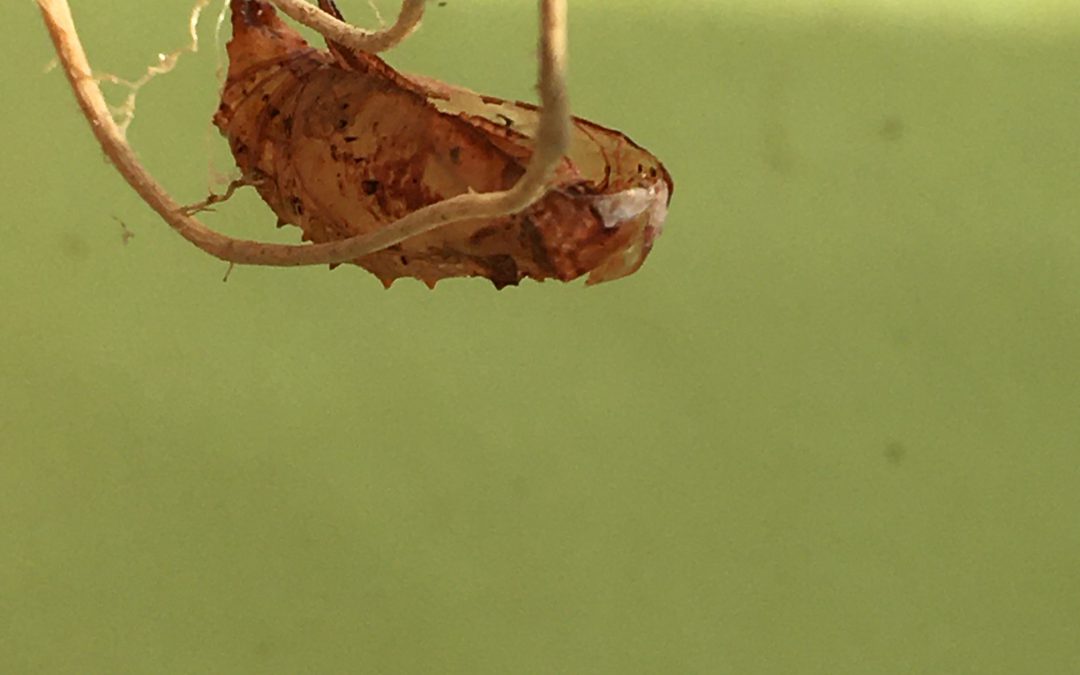
by Julie McConnell | May 13, 2020
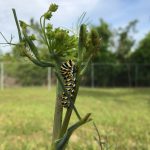
Eastern black swallowtail caterpillar on fennel. Photo: J_McConnell, UFIFAS
Working from home has given me the opportunity to take more notice of my landscape and allow more time for insect scouting. While looking for turfgrass pests a few weeks ago, I noticed a caterpillar I didn’t recognize feeding on a broadleaf weed in my lawn. Since it didn’t appear to be a typical turfgrass pest, I decided to collect a few and try to figure out what they were. I’m glad I did because it turned out they were Buckeye Butterfly larvae! This random find has led me to some experimentation with raising butterflies and I thought I’d share some tips in case others might like to try it.
**Before collecting be sure to consult the U.S. Fish and Wildlife list of endangered and threatened species in Florida and never collect from Florida State Parks or other dedicated conservation areas. Never release species not native to our ecosystem. **
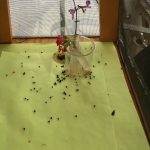
Lining the bottom of your enclosure with paper makes cleanup easier. Photo: J_McConnell, UFIFAS
You will need an adequate enclosure to keep caterpillars, chrysalises, and newly emerged butterflies/moths. I am fortunate to have a beautiful handmade cage constructed by a Master Gardener Volunteer at my disposal. It has a wooden frame and floor, screened walls, and the door latches. There are many options available for online purchase, but I would recommend getting one listed as “tall” or having a minimum height of 24 inches. Also, be sure you will be able to clean it easily – growing caterpillars create a lot of frass (excrement) that needs to be cleaned daily. I line the bottom of my enclosure with paper for quick cleanup.
Be sure you can offer fresh food for caterpillars and butterflies. Caterpillars usually have a limited menu of what they can eat depending on species. If you find them actively feeding on a plant, that is a pretty good sign that it is a good larval food source. Once you identify the caterpillar you can look up alternate larval host plants that the species eats.
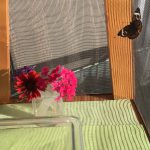
Provide a variety of fresh flowers when butterfly emerge
Collecting foliage and keeping it hydrated can be a challenge. I use small floral water tubes. They have rubber lids that pop on and off with slits where I can insert small stems, but the insects do not get in and drown. I usually set these in another container to keep them upright. I can easily add fresh flowers when I expect a butterfly to emerge so that nectar is available. If your enclosure is large enough you may be able to keep small potted plants inside, just remember to keep them watered.
Where do the caterpillars come from? I intentionally plant several plants that are larval butterfly (caterpillar) hosts such as parsley, fennel, and passionflower vine. I check these plants for caterpillars that I can collect along with foliage. After the butterflies emerge, I release them into my yard so they can find a mate and keep the cycle going.
For more information on attracting butterflies to your landscape see Butterfly Gardening in Florida.

by Larry Williams | Apr 23, 2020
One of the things to do while stuck at home due to COVID-19 restrictions, is to look for caterpillars and butterflies in your landscape. I’ve noticed giant swallowtail butterflies (Papilio cresphontes) a little early this year. The giant swallowtail is one of the largest and most beautiful butterflies in our area. Its larval stage is known as the orangedog caterpillar. This unusual name comes from the fact that it feeds on young foliage of citrus trees.
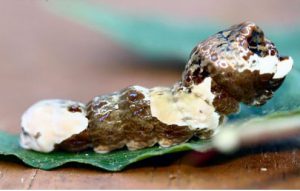
Orangedog caterpillar. Photo credit: Donald Hall, University of Florida
The orangedog caterpillar is mostly brown with some white blotches, resembling bird droppings more than a caterpillar. When disturbed, it may try to scare you off by extruding two orange horns that produce a pungent odor hard to wash off.
I’ve had some minor feeding on citrus trees in my landscape from orangedog caterpillars. But I tolerate them. I’m not growing the citrus to sell. Sure the caterpillars eat a few leaves but my citrus trees have thousands of leaves. New leaves eventually replace the eaten ones. I leave the caterpillars alone. They eat a few leaves, develop into chrysalises and then emerge as beautiful giant swallowtail butterflies. The whole experience is a great life lesson for my two teenagers. And, we get to enjoy beautiful giant swallowtail butterflies flying around in our landscape and still get plenty of fruit from the citrus trees. It is a win, win, win.
In some cases, the caterpillars can cause widespread defoliation of citrus. A few orangedog caterpillars can defoliate small, potted citrus trees. Where you cannot tolerate their feeding habits, remove them from the plant. But consider relocating the caterpillars to another area. In addition to citrus, the orangedog caterpillars will use the herb fennel (Foeniculum vulgare) and rue (Ruta graveolens) as a food source. Some butterfly gardens plant citrus trees to provide food for orangedog caterpillars so that they will have giant swallowtail butterflies. So you could plan ahead and grow some fennel, rue or find a butterfly garden in your area for the purpose of relocating the larvae.
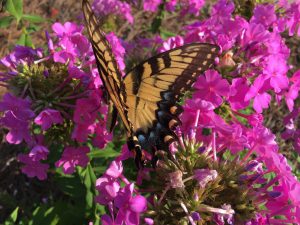
Yellow giant swallowtail butterfly on pink garden phlox flowers. Photo credit: Larry Williams
The adult butterflies feed on nectar from many flowers, including azalea, bougainvillea, Japanese honeysuckle, goldenrod, dame’s rocket, bouncing Bet and swamp milkweed. Some plants in this list might be invasive.
Keep in mind that mature citrus trees can easily withstand the loss of a few leaves. If you find and allow a few orangedog caterpillars to feed on a few leaves of a mature citrus tree in your landscape, you and your neighbors might get to enjoy the spectacular giant swallowtail butterfly.
More information on the giant swallowtail butterfly is available online at http://edis.ifas.ufl.edu/in134.
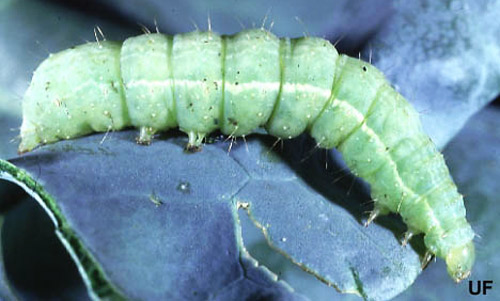
by Blake Thaxton | May 17, 2016
In the last few weeks, more garden pests have arrived! It is a fact of life in northwest Florida that we will have a few things in our garden including heat, moisture (humidity and rainfall), and BUGS! With a cooler spring the arrival of some of the troublesome pests in the garden seemed to be delayed a few weeks. It was nice while it lasted but the insect pests are here to stay until frost in the fall or winter (at least we hope for a frost this year).
There are thousands of insects that you can see in your garden. It’s wise to identify them before making a decision to spray an insecticide or remove them by another method. Insect samples can be taken to your local county extension office for identification.
In this article we will just discuss one of the top insect pests in the vegetable garden, caterpillars, and what you can do about them.

Mature larva of the cabbage looper. Photograph by John L. Capinera, University of Florida.
Beet armyworms, fall armyworms, hornworms, cabbage loopers, southern armyworms, tomato fruitworms, and other caterpillars love to feed on tomato foliage and fruit. They will show up eventually on tomato plants in the garden, if not this year then in the future. These larvae are immature moths and cause a lot of damage if left unchecked. The homeowner can control them effectively with Organic Materials Review Institute (OMRI) approved pesticides. A bacterial biological insecticide called Bacillus thuringiensis, also referred to as B.t., can be very effective in controlling these caterpillar pests. B.t. is a stomach toxin to these pests and will cause them to quit eating and starve to death. The key to using B.t. effectively is to routinely apply it before the caterpillars hatch from their eggs as the smaller caterpillars are easiest to control. Larger caterpillars are more difficult to control.
For more information related to using OMRI pesticides:
Organic Vegetable Gardening in Florida
Insecticides for Organic Commercial & Backyard Vegetable Production
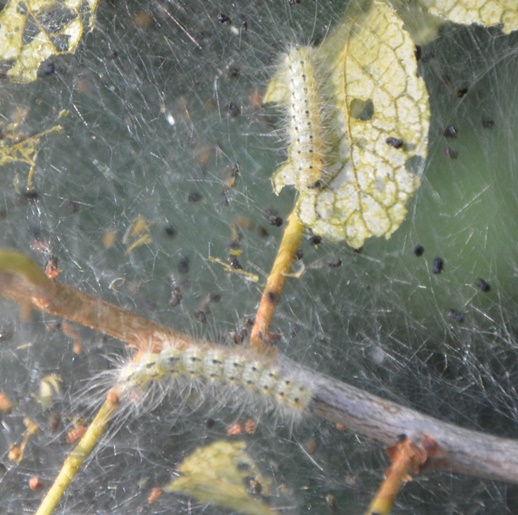
by Les Harrison | May 19, 2015
Uninvited guests can sometimes be fun and entertaining, bringing spontaneity to an otherwise predictable schedule. Sometimes the surprise guest is just an unpleasant distraction with no redeeming virtues.
The unanticipated knock on the door can bring both scenarios to mind. Almost everyone has an enjoyable cousin who regales listeners with amusing tales, and picks up the check for dinner.
Likewise, there are those potential callers with parasitic qualities, the appetite of a market hog, and initiative of a sloth. The Eastern Tent Caterpillar is one such visitor in north Florida.
These native caterpillars build large, thick nests on the branch forks and crotches of many kinds of trees, seeming to always choose the prized specimens highly valued by the homeowner. The silky tent shaped nests are easy to see and identity in host trees.
The caterpillars emerging in the spring of 2015 were laid in the spring of 2014. The adult moth lays her eggs in a single batch in May to July in the panhandle. There are 200 to 300 eggs laid in the group.
The mass of eggs are shiny, reddish-brown and look like dried foam. They are ordinarily about six inches back from the tip of a thin twig in host tree.
In approximately three weeks the eggs contain fully formed caterpillars, but the small caterpillars remain in the eggs until the following spring.
In late-February to mid-March they chew their way through their egg shells ready to eat their host tree that is entering the spring budding period with plentiful tender vegetation.
The voracious larvae immediately infest and, if in sufficient numbers, defoliate plum, cherry and many others. Normally the trees recover after a few weeks, but weakened or diseased trees may die.
When not eating, the newly hatched caterpillars construct their silk tent. The caterpillars use a pheromone trail to guild them back home when foraging is done.
A social insect, the eastern tent caterpillars congregate at their specific tent during the night and in rainy weather, expanding it to accommodate their growing size. These caterpillars do not feed within their nests.
The caterpillars disperse to colonize new areas when maturity is reached. They construct cocoons in protected places once they have sufficiently scattered.
Birds are not attracted to these hairy caterpillars. If they have a heavy concentration of black cherry leaves in their diet, the caterpillars will have a bitter acrid taste.
Parasitic wasps and weather are the two most common causes of caterpillar death. These caterpillars are especially susceptible to cold weather once they have emerged from their eggs.
About two weeks later, an adult moth emerges to begin the process again. Mating and egg laying commonly occur within 24 hours of the moths emerging from their cocoons
These brown moths are nocturnal and are seen flying only at night. They are an inch to two inches wingtip to wingtip at maturity and easy to overlook.

Tent Caterpillars are quick to hatch and eat their way through home landscapes.
Unfortunately, once they arrive for a visit they always overstay their welcome.
Contact your local UF/IFAS County Extension Office to learn more about Eastern Tent Caterpillars in north Florida.










